10 Tourist Attractions in Budva: What to See and What Places to Visit According to Historian and Montenegrin Resident Nikolay Stepanov
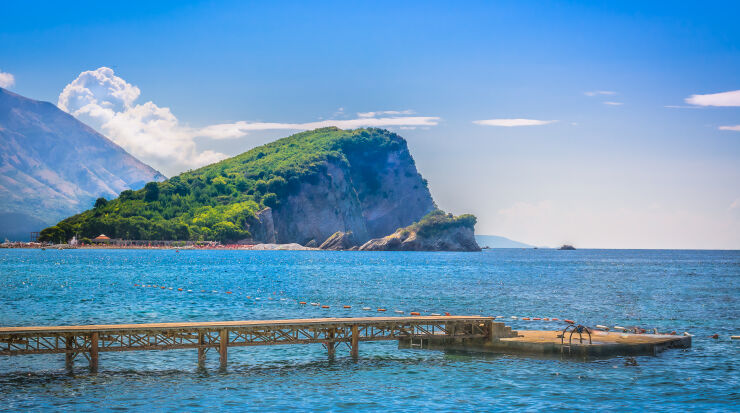
Discover theBudva attractions. Once you have read this article, you will learn in detail about must-see places in Budva and draw up a list of places you should visit.
Budva Riviera is an attractive site for tourists. However, a beach getaway is by far not the only thing that Budva has to offer to a traveler. Landscapes crafted by nature, famous and lesser known architectural monuments and Christian shrines are the resort's gems; their splendor mesmerizes you and makes you dream of revisiting Budva someday. What to see in Budva, Montenegro first? I’m pleased to share some tips.
I have selected the attractions for this review based on three criteria.
- Symbolism: each of them represents one of the Budva symbols.
- Accessibility: travelers do not have to spend a lot of time and money to get there.
- Popularity among travelers.
Table of Contents
The Difference Between Budva and Other Cities
Old Budva
New Budva
10 Budva Attractions that are Worth Visiting
1. Ballerina Statue
2. Citadel
3. Kosmac Fortress
4. Mogren Fortress
5. City Embankment
6. City Museum
7. Podmaine Monastery
8. St. John the Baptist's Church
9. Slavic Beach Slavic Beach is one of the largest beaches in Budva
10. St. Nicholas Island
Budva Municipality Territory
Transportation in Budva
Conclusion
About the Author
An acquaintance with any city should start with its key symbols. Budva has three symbols, and each of them embodies one of the hypostases of this magical place.
- The bronze statue of a dancer that you have probably seen on advertising brochures multiple times; a fragile maiden figure dancing gracefully among the rocks. This young ballerina is a true symbol of love.
- Located a few miles away from the center, at the city exit, the Mogren Fortress is the epitome of antiquity and grandeur. Coincidentally, the shortest way to this 19th century fortress is right past the Ballerina Statue.
Slavic Beach, the very symbol of the Budva Riviera. Blue, crystal-clear waters of the Adriatic, silk sand or small pebbles create an ideal place for a beach vacation.
Watch our YouTube video to see these sights ↓
A petite ballerina, a monumental fortress, and a breezy beach make up the basic list of Budva tourist attractions for anyone who wants to discover this city. Certainly, you may limit yourself to this list, but then the experience of visiting the city will not be complete, and its image in your mind will remain blurred and unclear, hardly much different from other southern seaside cities. If this is not enough for you and you are looking to truly absorb the spirit of Budva, you better continue your journey.
All the attractions are marked on the map; there is no need for you to search for each location described below.
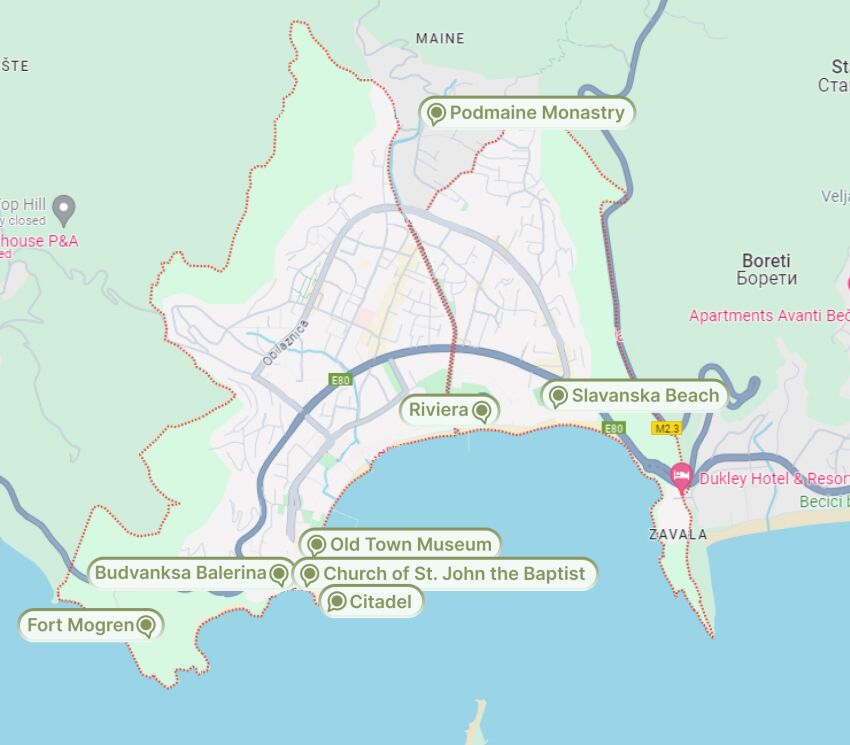
Map of Attractions and Popular Places in Budva The Difference Between Budva and Other Cities
"The capital of Montenegrin tourism", "A concrete monster", "Bludva" – there is a wide range of epithets for this seaside town. The Budva phenomenon involves both attracting and repelling everyone at the same time – from investors and foreigners with permanent residence to tourists. A person who lives in a big smoggy city always wants to get out of it, to go to the sea, to isolate themselves, to breathe the pure sea iodinated air in silence. And so they travel to the sea, to a small village filled with absolute quietness. 5-7 days of rest pass, then, a month, a year of stay, and sooner or later a city dweller, having lived in tranquility by the Montenegrin sea, begins to miss the city traffic, people, supermarkets, restaurants in walking distance, convenient goods delivery, and other familiar services. They do not wish to return to the provincial silence for a long time, even if it is near the sea.
Therefore, it is believed that Budva is the only Montenegrin city that can provide its guests with both seaside resort accommodation in the fresh sea air and urban pace of life with the benefits of civilization, food delivery, decent internet, and so on. It is this "two in one" phenomenon in Budva that both attracts and repels at first.
Old Budva
Montenegro has a distinction of "Old Budva" — it is a cozy Venetian town with narrow Italian streets, small but "otherworldly", and bounded by severe fortress walls. One can escape to Old Budva both in winter and summer; there are no crowds here, and in general there are fewer tourists than in the neighboring well-publicized Old Kotor. Also, the cozy streets of Budva are full of all kinds of stores and cafes, where you can easily get lost and immerse yourself in the atmosphere of the Italian Middle Ages.
New Budva
Yet all these people live, of course, in the new modern Budva, built at the turn of the 20th and 21st centuries. New Budva is a huge seaside town that has developed next to Old Budva. One can say the local houses were and are built overlooking Budva's Old Town, which is visible from the seafront and so easily recognizable with the bell tower of St. John the Baptist's Church overlooking its walls.
Budva's walkways along the beaches lead from the old town to the Zavala peninsula. Of course, beaches are always accompanied by restaurants, many of which are open all year round and do not close during the rainy season.
Large numbers of year-round restaurants are also among Budva's advantages. This "year-roundness" distinguishes Budva from neighboring resort settlements focused only on serving summer tourists; many cafes and restaurants there operate seasonally.
10 Budva Attractions that are Worth Visiting
There is no such question as what places to visit in Budva; it has so many attractions that it is hard to choose. It is harder if you have only 5-6 days to get acquainted with the city – this is the duration of most tourists' stay there. What sites should you visit in Budva in less than a week? Well, plenty of them. The key is to properly plan your route. Below you will find a description of Budva and a full guide to the top-10 attractions that will make you fall in love with Budva.
1. Ballerina Statue
The main symbol of the resort is the statue of a dancer
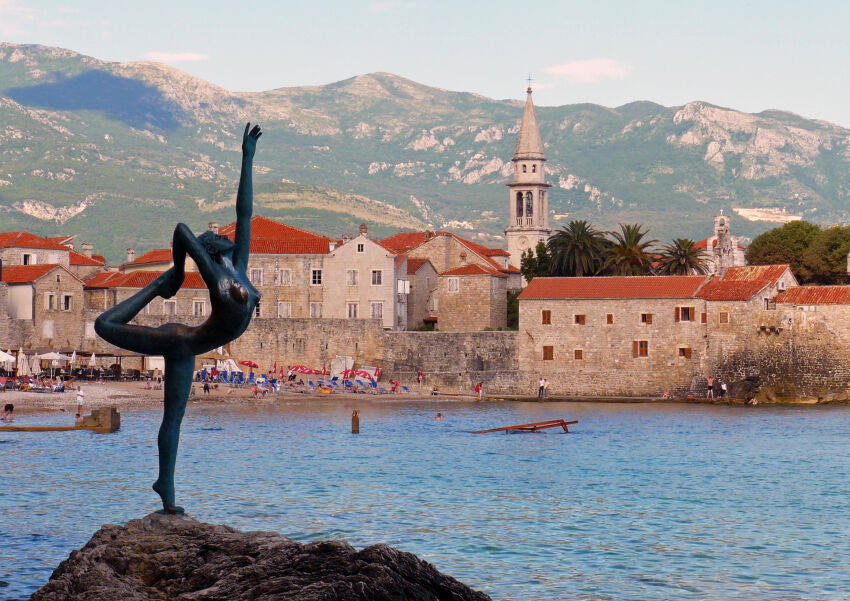
Statue (Monument) of a Gymnast "Dancer from Budva" That is why love is what we will start with. The statue of a dancer who gracefully pirouettes over the bay is considered to be the embodiment of the city's image. It is one of the most popular and photographed Budva attractions.
As a matter of fact, there are different opinions about the name of the sculpture. Some call it a dancer, some call it a ballerina, others call it a gymnast. All of these are correct, because the petite girl is a collective image, a symbol inspired by one of the local love legends. Although, no, not by one but by several of them. Some guides claim that it was a legend about a ballerina who threw herself off a cliff because of unrequited love, others tell the story of a young girl whose beloved never came back from a sea voyage. Still others recall the parable of a young man and girl who met a sea monster while swimming in the Adriatic. There are dozens of myths like this and all of them are romantic. So, yes, the "Statue of a Dancer" is about love.
The sculpture was created by Gradimir Aleksic in the second half of the last century, and was placed on the shores of Budva in 1965. The model for the sculpture was Serbian runner Olga Kalivoda, whom the sculptor met on a Croatian beach. Aleksic noticed the girl training near the water and asked her parents for permission to take a photo of the young (Olga was 14 at the time) athlete; her father gave his permission. It occurred three years before the creation of the "dancer".
Later Kalivoda recalled that the sculptor did not care about her appearance; he was looking for ideal proportions for his statue. Olga quit her sports career long ago, yet millions of tourists and Budva residents admire the statue to this day. You should admire it too, especially since the Adriatic views from that spot are truly fantastic.
2. Citadel
The Citadel is the hallmark of Old Budva
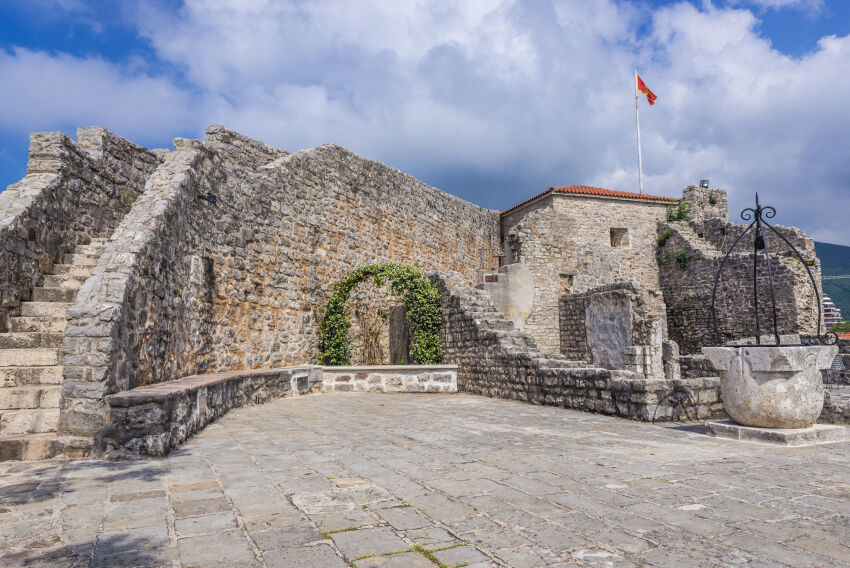
Citadel Fortress Museum Here is another one of the most recognizable landmarks and a symbol of Montenegro — the Citadel, also known as St. Mary's Fortress; one of the most impregnable and largest fortresses on the Adriatic coast. The fortress was built in the IX century; it aimed to repel Ottoman raids from the sea. Only a few elements of the original fort have remained: the eastern wall part and the northern tower.
In the XVI century the fortress passed to the Venetians, who rebuilt and strengthened it. If one can call it a thousand-year-old fortification's appearance modern, the castle acquired it in the century before last due to the Austro-Hungarians.
Citadel is built in the polygonal shape with fortress walls up to 2 meters thick and 10 meters high. It has a number of structures behind the walls: barracks buildings and squares. Nowadays, they are used for cultural events, such as concerts, festivals, exhibitions, and theater performances. The premises are not empty either; they include a luxurious library (the largest one in the city), the City and Maritime Museums with the richest expositions, and a cozy restaurant with traditional local cuisine. Imagine what it feels like to dine in a medieval fortress built prior to the first Crusades.
The walls are equipped with binoculars, offering the best views of the city and the surrounding countryside for only 3.5 euros. Citadel is located in the southeast of the city, in its historic part.
3. Kosmac Fortress
Austrian fortress on the Kosmac Hill
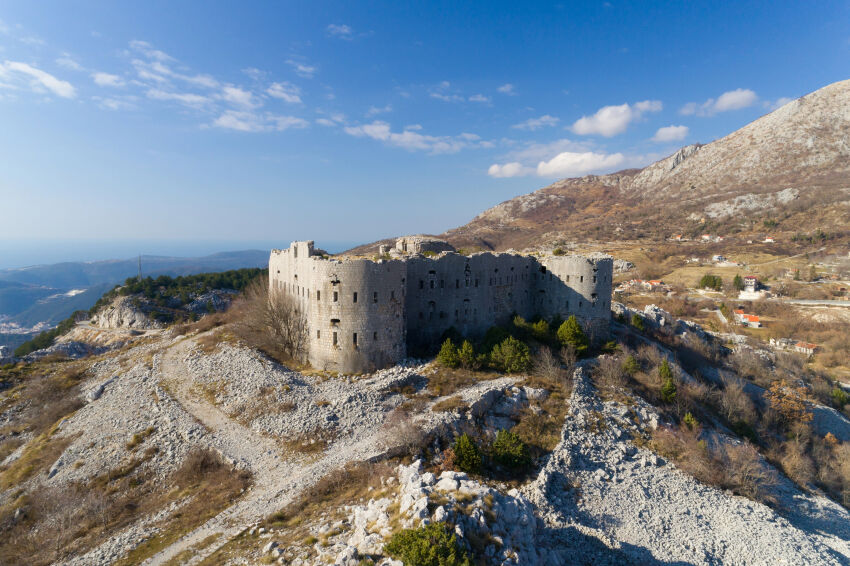
Austrian Fortress Kosmac Kosmac Fortress is one of the forts built by the Austrians in 1841-1850 on the border between then-Montenegro and Austria-Hungary. The fortification is located on Kosmac Hill, near the Brajići village, on the road from Budva to Cetinje. The fort rises 800 meters above sea level, allowing you to enjoy the marvelous views of the Riviera. These views are worth spending 20-25 minutes on the road from Budva in a rented car, and then walk a few dozen meters uphill.
Today Kosmac is in a dilapidated state, but it still makes a lasting impression with its monumentality and size. Round multi-story bastions, connected by stone walls with evenly laid gray bricks of facing, as well as arched openings and windows — this place could make a nice setting for a historical movie.
Alas, the fortress is gradually being destroyed. Though once it was one of the key fortifications between Austria-Hungary and old Montenegro. At least the fact that Emperor Franz Joseph visited Kosmac speaks of its bygone importance.
The area of all the fortress premises is over 1,000 square meters, and it was used for its intended purpose until World War II when its defense was occupied by Italian troops. The Montenegrin government is now attempting to reconstruct and restore the fortress to make it one of the cultural and historical centers of Budva.
4. Mogren Fortress
Partially ruined Austrian Mogren Fortress
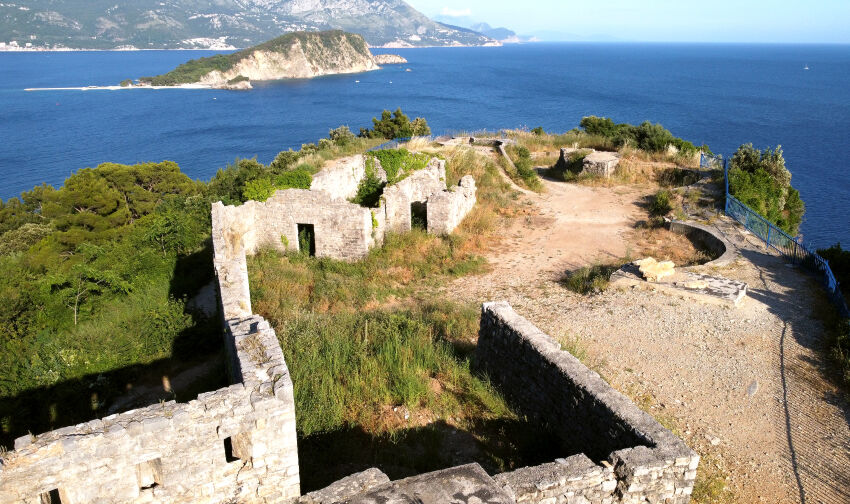
Mogren Castle Budva is the capital of powerful fortresses and defenses. Here is the thing. It was once a trading city, and the best advantage such a place can give to merchants and travelers is a convenient port and security. Not a single army ever entered the fortified walls with battles; governments changed without bloodshed, and the city continued to prosper and welcome visitors. Venetians, Austrians, Austro-Hungarians — each of the owners contributed to Budva's defense. That is the reason why there are so many forts and fortifications.
In 1860, the Mogren Fortress was built on the cape of the same name to protect it from the anticipated Ottoman invasions; its walls opened up a view of the entire town. Thick fortress walls connected four bastions, facing the sea with their loopholes. The fortress did not take part in military operations; it was built "just in case". Instead, it was actively used during the last century's world wars; the Austrians and then the Italians stored their weapons and supplies here.
Afterwards, the fortress was abandoned and began to deteriorate. In the earthquake of 1979, Mogren was badly damaged, and little of its former power remains nowadays. But even these remnants impress the experienced travelers who willingly take a half-hour walk from Budva to admire the unforgettable panoramas of the coast from the former fortress walls. By the way, it is quicker to get there by rented car; it only takes 10 minutes from the Old Town along the Jadranski highway towards Jaz beach, on the left before the first tunnel.
5. City Embankment
Promenade from the Old Town along the coast
Budva Embankment The embankment is the heart and another symbol of any resort town. In Budva it stretches for many kilometers along the city coast, almost to the suburbs. It is the busiest place, particularly during the summer season. The comfortable asphalt pedestrian walkway is surrounded by palm trees and velvet lawns with an abundance of flowers. All along the promenade you will find stores, souvenir stalls, excursion bureaus, cafes and restaurants, where you can taste dishes of any world cuisine. Evenings are illuminated by noisy dance floor lights.
The Adriatic views from the seafront truly deserve your admiration! It is great to relax in one of the cafes, enjoying the sea panorama, or stroll along the coast after sunset, catching the reflection of city lights in the soft waves. However, the views are not all there is to marvel. On the seafront there is plenty of room for those who like to spend time actively: parasailing, other attractions and, of course, boat cruises. The Riviera shore is dotted with beaches, quiet small bays, and rocks of incredible beauty; you can admire them during your sea trip. Starting from there, you can also go on an excursion to one of the bay islands. For example, to the beautiful island of St. Nicholas. Fishing lovers can rent a boat to fish away from the noisy resort entertainment.
Besides, it will take you a total of 1.5 hours to walk by the sea along the comfortable walkway from Mogren Beach to Kamenovo Beach. Such a leisurely walk with photo stops in picturesque places usually takes from 1.5 to 2 hours. On your way you will pass through 2 tunnels; you will walk along the embankments not only in Budva, but also in the neighboring resort towns of Becici and Rafailovici.
6. City Museum
A small archaeological museum in the Old Town
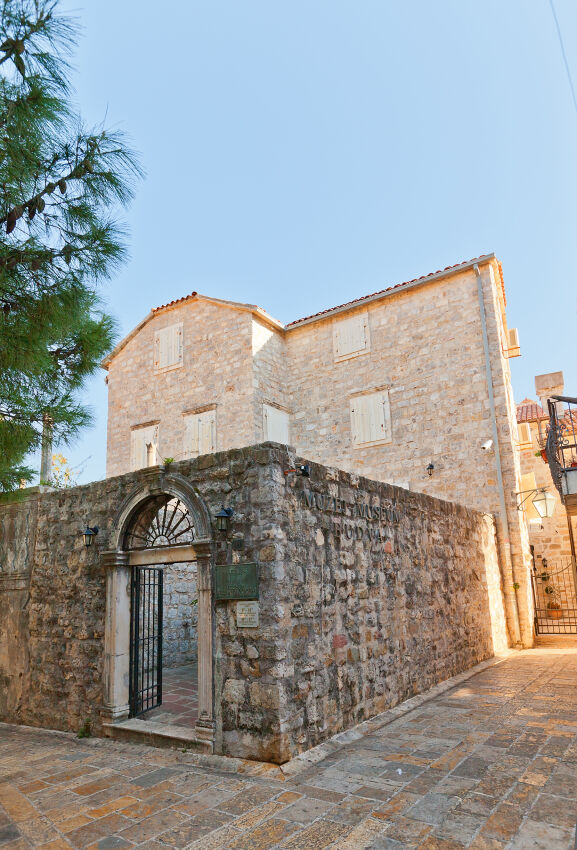
Archaeological City Museum Budva City Museum will undoubtedly arouse the interest of all those who came to Montenegro not only to lounge on the beach, but also to learn more about this beautiful country's past. The museum was opened in 1962, and its excursions have been organized quite recently, in 2003. The exposition contains about 3,000 exhibits representing the history of the region since IV-V centuries BC. Yes, there is a lot of archaeological evidence that Budva existed in the V century BC and was founded by natives of Hellas.
There are four floors in the building and the passage between them resembles a journey through time. The first floor is dedicated to the lapidarium with roughly hewn slabs with samples of ancient writing and stone urns of ashes. On the second and third floors an intrigued traveler can immerse himself in the life of the ancient Romans and Byzantines; there are kitchen utensils, coins, dishes, and even armor of the ancestors of the Montenegro inhabitants.
The exhibits on the last, fourth floor depict the life of Montenegrins from the 18th century to the last century. National costumes, military equipment, household items, nautical devices, furniture, and utensils are displayed there; everything that describes Budva's life throughout two centuries.
1.5-2 hours will be enough to explore the exposition, and after that you should continue your journey through the colorful, unique, eternally young, and yet incredibly ancient Budva. A stroll through the resort's modern streets after visiting the archaeological museum is a very rewarding experience.
7. Podmaine Monastery
Podmaine with ancient churches nearby the Old Town
Podmaine Orthodox Monastery Podmaine Monastery (also known as Podostrog) is located approximately 2.5 kilometers from the Old Town and was founded in the Xll-XlV centuries. Externally, the complex reminds of a well-fortified fortress with massive walls and a bell tower resembling a round bastion. It is located in a picturesque area, surrounded by mountains and forests.
The location of the monastery gave it its name, in fact, both of the names. The point is, the word "podmaine" referred to the brotherhood that used to live on these lands, and "podostrog" is a derivative of the name of Mount Ostrog; the monastery stands beneath it. The monastery did not always have a modern appearance. At first there was only a small Dormition of the Virgin Mary church, the rest of the buildings appeared much later.
Centuries passed, and the church grounds were joined by household buildings, fortifications, and walls equal to those of the fortress. Why was it fortified? The fact is that Podmaine attracted the closest attention of those who attempted to invade Montenegrin land in different eras: the Venetians, the French, and the Austrians. Moreover, the Austrians even used the monastery as barracks once. If the building had not been bought by a local cleric, there would hardly be anything left of it today.
In the 80s of the last century the complex was restored and nationalized, and in 1995 it was returned to the church. Now the monastery is active; pilgrims come here from all over the world. The territory houses two churches, and the semicircular open terrace offers a breathtaking view of the Adriatic.
The monastery is very accessible; it is only half an hour's walk from the Old Town or directly from the seafront.
8. St. John the Baptist's Church
The largest Catholic church in the city on the square near the Citadel
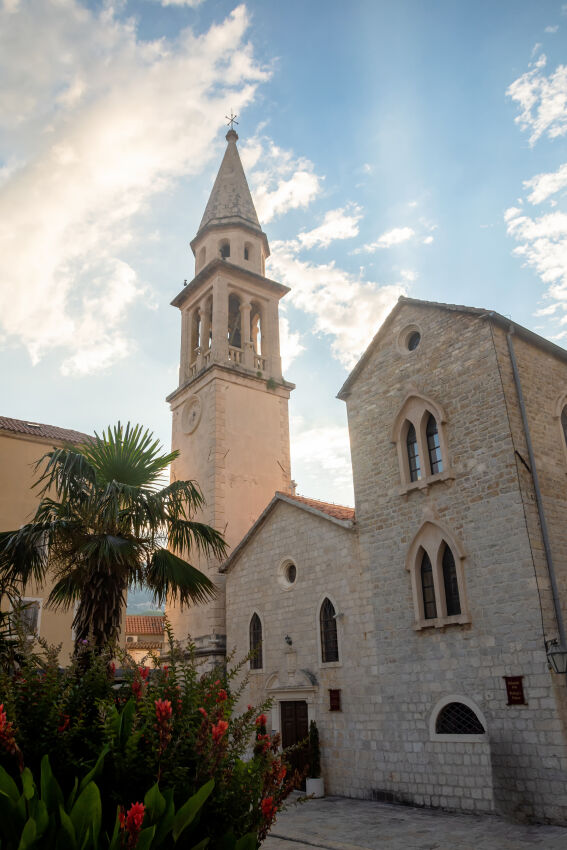
St. John the Baptist’s Cathedral The very best. These are the words that one can confidently add to any epithet referring to the St. John the Baptist's Cathedral in Budva. This most authentic Catholic church, not only in Budva but perhaps in the whole of Montenegro, is located in the Old Town.
The spiky bell tower of the church soars above the central square like an arrow that strives to touch the blue and satin skies at all costs. This spectacle mesmerizes and forces you to drift away with your thoughts to otherworldly matters. That is why it is definitely worthwhile to stay at the church for a few minutes and enjoy the view.
At the same time, the exterior of the church looks quite austere, if not ascetic: it is a building with three naves, a vaulted roof and a chapel attached to the side. And right next to the church is the former bishop's palace with its rough neo-Gothic exterior, another Budva attraction popular among tourists.
The cathedral fascinates not only due to its architecture, but also because there is much to see inside. There is a rich collection of priceless icons; the walls are decorated with glass mosaics and paintings by Venetian artisans. The cathedral preserves some of the rarest old books and archival documents, regularly displayed inside the church for everyone to admire.
9. Slavic Beach
Slavic Beach is one of the largest beaches in Budva
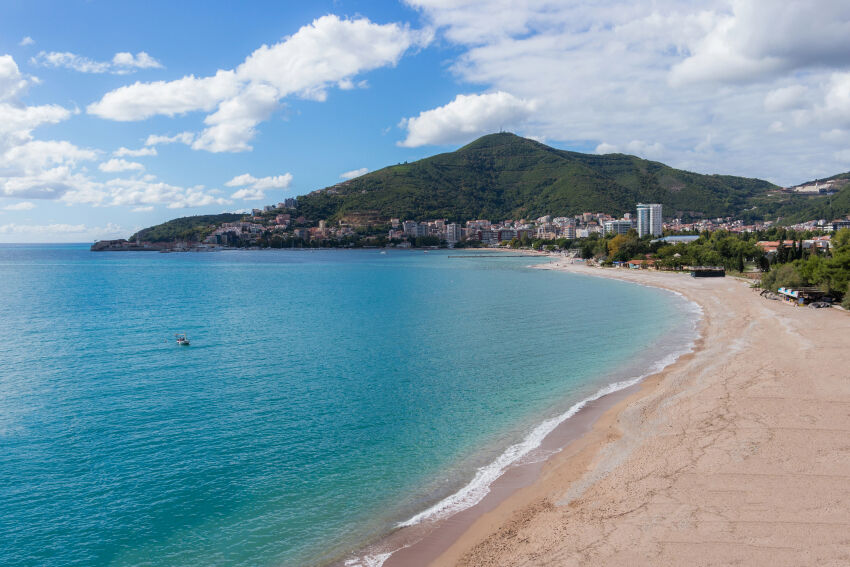
Slavic Beach in the Budva Riviera Montenegro is a paradise island washed by the Adriatic's blue waters. A tiny country that has, just think about it, over a hundred beaches; many of them are awarded with the Blue Flag! And, of course, people come here mainly for beach vacations. Slavic beach extends for over a mile and a half along the bay coast; it has both sandy areas and those that are covered with small pebbles.
Since Slavic beach is the closest to the city, there are always many travelers during the season. But the busyness is compensated by its well-being as well as a comfortable and smooth water approach. There are plenty of sun beds, changing cabins, wooden paths to the edge of shore, massage stations, and even Wi-Fi. Active recreation enthusiasts will find familiar entertainment there: water skiing and parasailing, various attractions, sports fields for volleyball, ping-pong, and other mobile games.
Next to the beach, the promenade is packed with fast food and ice-cream cafes. Well, and when the chattering and crowded Slavic beach tires you out, you can always take a stroll to another one; luckily, there are plenty of them in the Budva surroundings.
By the way, as you walk past the resort villages, you may think that Becici and Rafailovici beaches are more comfortable than those in Budva — they are wider and more spacious. Also, Becici and Rafailovichi beaches are equipped with adjoining parking lots. Many Budvans, as Budva residents are called, tend to visit the Becici beaches, leaving the overcrowded Budva town beach "Slovenska Plaza" to the tourists who have had a chance to get to the sea.
10. St. Nicholas Island
St. Nicholas Island or Shkol in the Adriatic Sea
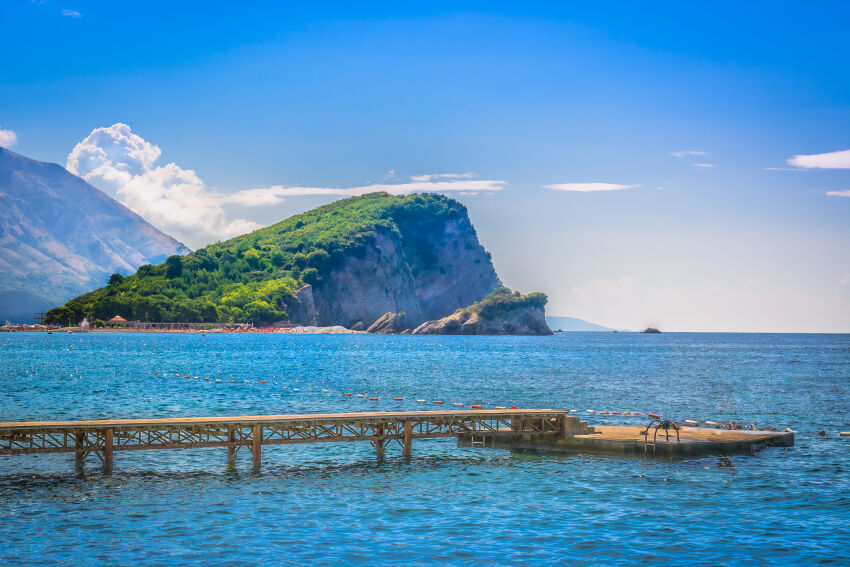
St. Nicholas Island in the Adriatic Sea Another escape from the crowds of Budva's main town beach in the summer months is St. Nicholas Island, spreading in the sea in front of Budva approximately 1 mile away. The island is called "Hawaii'' by clever carriers and is regularly visited by boats; its beaches are considered to be cleaner and less crowded. The island is a true gem for panorama lovers of the Budva Riviera; the cliff overlooks a spectacular view.
Besides, the island, which can be seen from any point of the bay, got the name "Hawaii" because of the restaurant of the same name located there. In the XI century, the Crusaders erected a small church on a piece of land and the island earned its official name.
The island of St. Nicholas is not large, just about 2 miles long. And yet it is uninhabited. That is, absolutely and irrevocably. Moreover, certain parts of the island are still not accessible — they are closed to the public. Thus, only the sea, the sun, the coastal area with sun loungers, a restaurant, a couple of cafes, and a tray with ice cream are at the service of guests. Yet the water there is incredibly clear and clean, and its color looks exactly like on the posters advertising luxury resorts. And most importantly, nobody needs to look for a free sunbed and a place under the sun on this beach.
Access to the island is easy: simply take one of the boats that leave every half an hour from the pier to the island right on the beach in Budva. You will need to buy a round ticket. If you want to occupy a sun bed directed towards the open sea where the water under your feet is the most beautiful, it is better to get to the island on the first boat trip, around 8-9 a.m.
Budva Municipality Territory
Local toponyms remind of unquiet Budva history, Slavic tribes of Maini and Pashtrovici who in fact were subjects of the Most Serene Venice. Nowadays, the names of the local warlike brotherhoods are evident in the names of the resort villages of the Budva Riviera: Rafailovici, Becici, Boreti, Markovici, Braici, and Kuljaci.
The mentioned neighboring seaside towns are part of the "Great Budva". Today these are the municipality lands (locally called "opshtina") of Budva, consisting not only of the city but also the neighboring former villages, now independent resort villages.
The Budva municipality is located in the southwest of the country and stretches for 20 miles along the Budva Riviera coastline. It is the largest tourism center in Montenegro: the total length of the municipality's beaches is 8 miles.
About half of the tourist traffic to Montenegro accounts for Budva and its surroundings. Budva, as well as Becici, Sveti Stefan, Petrovac, and other towns attract about half a million travelers per year. So, tourists are very much welcomed, loved, cherished, and appreciated here.
Transportation in Budva
You do not have to walk along the towns of the Budva Riviera. The local shuttle bus lines "Budva – Petrovac" and "Budva – Sveti Stefan" operate through them. The final local bus stop is located in a five-minute walk from the walls of Old Budva.
Of course, the city also has cabs. Cab drivers are divided into "gray" cab drivers, who are on duty at every corner, while their prices make wallets of any size thin, and "network" cab drivers. These are cab drivers with cheaper fares working through a dispatcher who are approved by the Opshtina. Finding a network cab is more difficult; you need to know the dispatcher's phone number to book a car at the right price and, at the very least, speak English. However, you can easily request for a "network" cab through a restaurant waiter, a hotel employee or simply ask any passerby to do it, unless they are a tourist, of course.
Most of Budva attractions are within walking distance and can be reached on foot. These include the already mentioned "Statue of a Dancer", the Citadel, St. Nicholas Island, accessible from Budva beach by boat, Mogren Fortress, Podmaine Monastery and others.
If you want to visit other places near Budva, such as Rustovo Nunnery, Kosmac Fortress or the cave in Becici, you will have to take a bus, rent a car or hire a cab. So, keep this in mind when choosing what places to visit in Budva.
Transportation rates vary; an intercity bus ride costs 15-20 euros because public transit is expensive there. Cabs charge different prices as well: a ride within the city costs about 5 euros, and more expensive outside the city. The best option is to equip yourself with a good and informative map and rent a car.
Conclusion
We have finished our virtual walk around the beautiful pearl of the Adriatic. In case you get bored with the resort crowds, consider a day trip to St. Nicholas Island that attracts travelers like a magnet with turquoise waters and vacant sun loungers. And on your way back to the hotel, be sure to stop at the City Museum with countless treasures of civilizations once residing in Budva. Come and explore the things to see in Budva and you will be surprised.
About the Author
Nikolay Stepanov is a licensed Montenegro guide and historian. He has been living in Montenegro for over 10 years. He organizes author's tours in Montenegro with historical and analytical focus. At the same time, he tries to make the tours opposite to tedious and boring.
He has been published and quoted in the Serbian and Montenegrin press, resulting in friendly contacts among the local scientific elite. He is published in Serbia's oldest and most influential newspaperPolitika, the Russian portal about MontenegroOpenMonte, the newspapers Vesti andSloboda Reč. In his research he exclusively relies on local archival and scholarly sources.

